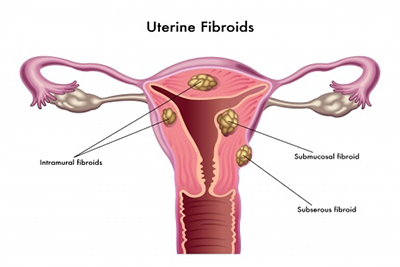Understanding Uterine Fibroid
Understanding Uterine Fibroid

Fibroids are the most common benign tumors of the uterus. They usually come in a variety of shapes and sizes, as well as numbers, in the uterus. Very rarely do they turn to cancer – the exact incidence being less than 1% in a patient’s lifetime. Women who are at risk usually have a family history, are Black or Hispanic, and may have an elevated Body Mass Index (BMI). As a matter of fact, because we are seeing more women with an increase in BMI, Caucasian women are presenting with fibroids more frequently as well. While there is still a lot to understand about the development of fibroids, they grow for two reasons: hormones, in particular estrogen and blood supply.
Fibroids can be located in different parts of the uterus. Just like real estate, it’s all about location, location, location! There are some fibroids that are located underneath the surface of the uterus, which are called subserosal; these generally do not cause bleeding but can cause pressure. There are those that are embedded in the muscle of the uterus, which are called intramural. Finally, there are those fibroids that affect the lining of the uterus, which are called submucosal, and these are the ones that usually present with excessive bleeding.
Symptoms And Tests
The most common symptoms of fibroids are heavy bleeding, pressure, increased frequency in urination and pelvic pain. Although most fibroids do not usually cause pain, if they outgrow their blood supply, it can cause pain due to degeneration (which means tissue breakdown). Fibroids are usually diagnosed with a pelvic exam and a pelvic sonogram. Transvaginal sonography is very good at detailing whether a fibroid is affecting the uterine lining or not.
While the leading cause of hysterectomies is fibroids, there are many more conservative treatments that are available now. Birth control pills are one of these treatments; not only can they suppress bleeding, but they can also suppress the hormones that can control the growth of the fibroid. Decreasing weight also decreases the amount of exogenous estrogens that can control the growth as well. Uterine artery embolization can cut off the blood supply to the uterus, thus controlling growth and bleeding. In the case of submucosal fibroids, they can be resected hysteroscopically by going into the uterus and removing the fibroid through the vagina. Another procedure called a myomectomy just removes the fibroids, thus conserving the uterus. Lastly, you can also just watch them: If they don’t bother you, don’t bother them. Specific treatment modalities should be discussed with your physician to see what works best for you.
Effects On Pregnancy
One of the most common concerns that I am asked about in my clinical practice is whether the patient can become pregnant with a fibroid. Again, location is key. Depending on where it is, whether it affects the cavity where the baby grows or blocks the fallopian tube for fertilization, treatment will be dictated by these factors. If those issues are not present, women can become pregnant and have a normal pregnancy. All these issues should be discussed with your physician prior to pregnancy to determine your specific needs. Fibroids will grow during pregnancy, often experiencing the greatest growth during the first trimester.





